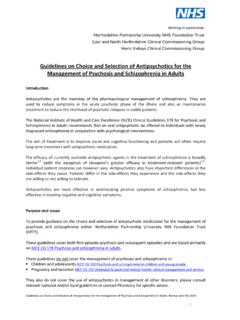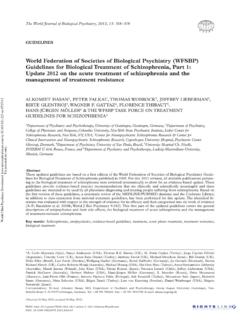Transcription of Guidelines for the Treatment of Schizophrenia …
1 Guidelines for the Treatment of Schizophrenia during pregnancy and the Postpartum Period Treatment Guidelines for the management of thought disorders during pregnancy and lactation are sparse relative to mood disorders. However, the Guidelines for Major Depression (Wisner et al 2000) and Bipolar Disorder (Yonkers et al in press) serve to provide a framework for all illnesses. The shared goal of Treatment team and patient, when managing Schizophrenia during the peripartum, is to maximize maternal and infant well-being while minimizing exposure to medications, mental illness, and environmental toxins (Stowe et al. CNS Spectrums 2000). Achieving this aim requires a comprehensive risk-benefit assessment that includes: 1) the likelihood of relapse or exacerbation if Treatment is discontinued, 2) the potential effect of untreated maternal mental illness on fetal-infant development, 3) the efficacy of available treatments, and 4) the unique management issues of such treatments during pregnancy or lactation.
2 Women with Schizophrenia have high rates of unplanned pregnancies, and psychotic disorders have been reported to worsen during pregnancy . Postpartum psychosis (PPS) is a well- documented psychiatric emergency. Several lines of investigation have demonstrated that a history of psychosis increases the risk for PPS. Untreated psychosis either in pregnancy or the postpartum poses significant consequences for both mother and child. Similarly, maternal Schizophrenia is associated with higher rates of prenatal substance abuse, obstetrical complications, and infant death. Women with Schizophrenia may have bizarre ideas about pregnancy that complicate their perinatal course or aberrant parenting styles that may impair child development. Antipsychotic medications were introduced almost 5 decades ago, and many clinicians have forgotten that their original use was for nausea during pregnancy .
3 Today, haloperidol continues to have a role in the Treatment of hyperemesis gravidarum. The aliphatic phenothiazines were associated with a higher rate of major anomalies, but higher potency antipsychotics have not been associated with changes in gestational duration, infant birth weight, infant survival, or rates of major malformations. Case reports of neonatal jaundice, intestinal obstruction, muscular hypertonia, and neuroleptic malignant syndrome exist. Whether these cases were related to anticholinergic agents utilized for EPS remains obscure. Special attention to dose strategies for the typical antipsychotics is warranted to minimize or avoid the use of anticholinergic agents. Neonates should be observed for any signs of side effects such as neuroleptics malignant syndrome (NMS) and extra pyramidal side-effects (EPS).
4 Despite their acceptance as first line agents for Schizophrenia and as well as an expanding array of other psychiatric illnesses, atypical antipsychotics have limited data with regard to reproductive safety. The most extensive data exist for clozapine, but the agranulocytosis risk and requisite leukocyte monitoring in neonates and nursing infants has limited its utility. A scattered series of case reports and a registry for olanzapine is the extent of data for other atypicals, and has not demonstrated evidence of perinatal toxicity or teratogenesis. Gestational diabetes is a theoretical concern, reported only with clozapine to date; however, close monitoring of maternal blood glucose for these agents is prudent. In summary, the perinatal risks of Schizophrenia mandate that Treatment should not be discontinued routinely without full consideration of the risk of relapse to the mother, which itself may have adverse effects upon carrying the foetus to term as well as neurodevelopment.
5 Given their longstanding use, high potency typical antipsychotics, particularly haloperidol, remain agents of choice; however, doses should be limited to avoid anticholinergic co-administration. Because reproductive safety data for atypical antipsychotics remain sparse, routine use is not yet recommended. Ultimately, however, Treatment must be individually tailored. In particular, -1- unplanned conception during atypical antipsychotic Treatment usually dictates that continuing the atypical Treatment which the patient tolerates, from which she derives benefit and to which the fetus has already been exposed is preferable to switching to a typical antipsychotic which the patient may neither tolerate nor find beneficial and to which the fetus has not yet been exposed. --Zachary N. Stowe & D. Jeffrey Newport Annotated References Goldstein DJ, Corbin LA, Fung MC: Olanzapine-exposed pregnancies and lactation: early experience.
6 J Clin Psychopharmacol 2000; 20: 399-403. This published birth registry of 23 prospectively ascertained olanzapine-exposed pregnancies from the Lilly Worldwide Pharmacovigilance Safety Database reported no major congenital malformations, 13%. spontaneous abortions, 5% preterm deliveries, and 5% fetal demise. It is the only published data from an atypical antipsychotic pregnancy registry. McNeil TF, Kaij L, Malmquist-Larson A: Women with nonorganic psychosis: mental disturbance during pregnancy . Acta Psychiatr Scand 1984; 70: 127 139. This study of 88 pregnant women with a history of psychosis and 104 pregnant control subjects reported high rates of mental disturbance in those with a history of psychosis, with most severe symptoms reported by those with Schizophrenia . Milkovich L, Van den Berg BJ: An evaluation of the teratogenicity of certain antinauseant drugs.
7 Am J Obstet Gynecol 125: 244 248, 1976. This large prospective study, encompassing nearly 20,000 women treated primarily with phenothiazines for emesis, found no significant association with neonatal survival rates or severe anomalies after controlling for maternal age, medication, and gestational age at exposure. Miller LJ, Finnerty M: Sexuality, pregnancy , and childrearing among women with Schizophrenia -spectrum disorders. Psychiatr Serv 1996; 47: 502-506. This study compared 46 women with Schizophrenia -spectrum disorders with 50 female controls. Those with a Schizophrenia -spectrum disorder demonstrated higher rates of unplanned and unwanted pregnancy , prenatal substance abuse, elective abortion, obstetrical complications, parenting difficulties, and loss of custody. Newport DJ, Fisher A, Graybeal S, Stowe ZN. Psychopharmacology during pregnancy and lactation.
8 In Schatzberg A, Nemeroff CB, eds. The American Psychiatric Publishing Textbook of Psychopharmacology, 3rd Edition. Washington DC: American Psychiatric Publishing, Inc., 2004, pp. 1109-1146. This chapter is the most recent of numerous reviews of pharmacotherapy during pregnancy and lactation. It proposes that minimizing infant exposure is the primary objective of perinatal psychiatric care and offers recommendations for achieving that goal in the management of various psychiatric disorders, including Schizophrenia . Riordan D, Appleby L, Faragher B: Mother-infant interaction in post-partum women with Schizophrenia and affective disorders. Psychol Med 1999; 29: 991-995. This is a study of 26 women who had recently recovered from a postpartum onset episode of mental illness requiring hospitalization. Compared to those with a mood disorder, women with Schizophrenia exhibited poorer mother-infant interaction, and their infants at 4 months of age were more avoidant.
9 Rumeau-Rouquette C, Goujard J, Huel G: Possible teratogenic effect of phenothiazines in human beings. Teratology 1977; 15: 57 64. This study encompassing deliveries reported a significant over-representation of prenatal exposure to phenothiazines with an aliphatic side chain among 189 babies with major malformations. -2- Stowe , Calhoun K., Ramsey C., Sadek N., and Newport The Course and Treatment of Mood Disorders in Women during pregnancy and Lactation . CNS Spectrums 6(2): 150-166. (2001). Review article that outlines the pathways of exposure for both mental illness and medication use during pregnancy and lactation. Van Waes A, Van de Velde EJ: Safety evaluation of haloperidol in the Treatment of hyperemesis gravidarum. J Clin Pharmacol 1969; 9: 224 227. This study of 100 women treated with haloperidol (mean dose mg/day) for hyperemesis gravidarum, detected no differences in gestational duration, fetal viability, or birth Yonkers ,, Wisner K.
10 , Stowe , Leibenluft E., Cohen L., Miller L., Manber R., Viguera A., Suppes T., and Altshuler L. management of Bipolar Disorder during pregnancy and the Postpartum Period . American Journal of Psychiatry (accepted). Review article by an expert panel on perinatal psychiatry. Wisner K, Zarin D, Holmboe E, Applebaum P, Gelenberg A, Leonard H: Risk-benefit decision making or Treatment of depression during pregnancy . American Journal of Psychiatry 2000;. 157:1933-1940. Review article outlining Treatment Guidelines for Major Depression during pregnancy and lactation. -3.





